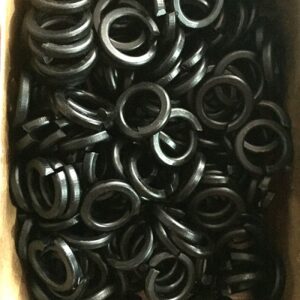Operating procedures for spring blackening process
(I) start the power supply to heat the tank liquid to the boiling point and remove the iron oxide (sediment) in the tank;
(II) after removing the sediment, add about 0.5kg yellow blood salt (potassium ferrocyanide);
(III) add a certain amount of sodium nitrite (in accordance with 5 ~ 8:1) according to the technical requirements of blackening process;
(IV) use a thermometer to measure the humidity of blackened tank liquid to ensure that the tank liquid temperature is 140 ~ 144 ℃. If the temperature is too high, add water and control the heating power supply;
(V) before blackening, the spring must be fully pickled and cleaned, and the tension spring must be vertically framed for easy cleaning;
(VI) in case of blackening, the process and technical requirements must be strictly implemented, the oil residue on the liquid level shall be removed in time, and the tank liquid shall be supplemented in time;
(VII) after blackening, the spring shall be sprayed and washed with high-pressure water, washed with boiling water, and the saponification temperature shall be controlled at 50 ~ 60 ℃;
(VIII) the spring shall be framed and warehoused after excessive oil is drained. The iron frame with the spring removed must be sprayed and washed with high-pressure water before reuse.
(IX) when off duty, add a certain amount of sodium hydroxide (conforming to 5 ~ 8:1) into the oxidation tank and turn off the power supply. Clean and clean the work site and keep the site clean and tidy;
Precautions during blackening process operation
(I) if yellow frost is found on the oxidized workpiece, it indicates that the tank liquid temperature is too high and the water content is too little.
(II) the oxidized workpiece is not black and gray, which is due to low bath temperature or lack of sodium nitrite.
(III) if the boiling point of the oxidation tank is below 140 ℃, sodium hydroxide shall be added.
(IV) soap flakes or triethyloleic acid soap shall be frequently added to the saponification tank to maintain a certain concentration.
(V) the oxide film of silicon containing steel is allowed to be brown or brown black;
(VI) the self inspection of blackening quality of the workpiece shall be carried out before the spring oiling process. It is qualified if there is no copper precipitation after soaking in 2% copper sulfate solution for 30 seconds.
3% copper sulfate drop test. The etching test shall be conducted by dropping copper sulfate or 2% copper sulfate on the workpiece, completely immersing the workpiece into the copper sulfate solution, and it is qualified if the oxide film does not change color after 30 seconds. The drip test and etching test shall be carried out before the workpiece is oiled. During the sampling inspection of finished products, the oil stain shall be removed with wine cleaning first. The blackened and oxidized workpieces will not rust within one year after normal storage.
Phosphating treatment of spring

Phosphating is a process to prevent the corrosion of springs in transportation and use. Phosphated springs have corrosion resistance in air, animal and vegetable mineral oil, toluene and other organic solvents. The spring is suitable for zinc phosphate treatment to avoid hydrogen embrittlement. The phosphating film is thicker than the oxide film, generally 5 ~ 10 microns.
Generally, phosphating has better corrosion resistance than oxidation. In particular, phosphating treatment is suitable for the previous process of the protective frame on the spring.
(1) Spring phosphating process cold and hot water
(1) Oil and rust removal – copper removal – Cleaning – phosphating – Cleaning – passivation – Cleaning – saponification – water immersion film replacement oil – Warehousing






